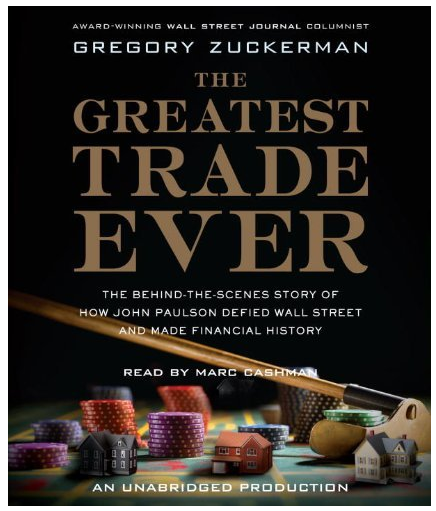 The WSJ’s Greg Zuckerman has a new book out titled, The Greatest Trade Ever: The Behind-the-Scenes Story of How John Paulson Defied Wall Street and Made Financial History.
The WSJ’s Greg Zuckerman has a new book out titled, The Greatest Trade Ever: The Behind-the-Scenes Story of How John Paulson Defied Wall Street and Made Financial History.
Here is an excerpt from his recent WSJ column on lessons on the subject:
1 Don’t Rely on the Experts
Many investors lost big in 2007 and 2008 as housing crumbled and the stock market tumbled. But no one lost more than commercial and investment banks caught with toxic mortgage-related securities. These bankers were the very same ones who created these investments, and Wall Street’s top analysts had vouched for their safety, even as Mr. Paulson and others bet against the investments.
Lesson: When Wall Street is wheeling out its latest can’t-miss product, be skeptical.
2 Bubble Trouble
Some academics argue that financial markets have become more efficient. But a rash of financial bubbles in recent years — including housing, energy, technology and Asian currencies — suggests that markets are becoming harder to navigate, and are more prone to overshooting. Today, investors of all sizes read the same articles, watch the same business-television programs and chase the same hot tips. They invariably head for the exits at the same time.
Lesson: Have an exit strategy — and cash to cushion any tumble.
3 Focus on Debt Markets
Most investors track the ups and downs of the stock market but have only a vague sense of moves in debt markets. That’s a mistake. Early signs of trouble were seen in sophisticated markets that don’t get much limelight, like the subprime-mortgage bond market. These problems eventually felled the housing and stock markets, and the overall economy, a set of falling dominos that Mr. Paulson and his team correctly anticipated.
Lesson: Debt markets can do a better job predicting problems than stock markets.
4 Master New Investments
Mr. Paulson scored huge profits by buying credit-default swaps, a derivative investment that serves as insurance on debt. When risky mortgage bonds tumbled in value, Mr. Paulson’s insurance soared. But many experts were flummoxed by CDS contracts or shied away from educating themselves about these relatively new investments.
Mr. Paulson and his team had no experience with CDS contracts. But they put the time into learning about them.
Lesson: Educate yourself about the range of exchange-traded funds being introduced, some of which can play a valuable role in a portfolio.
5 Insurance Pays
A number of investors worried about a bursting of the housing market, but few did much about it, even though insurance, such as CDS contracts, at the time were selling at dirt-cheap prices. Out-of-the-money put contracts — options that pay off only if the market tumbles — also were trading at reasonable levels. As cheap as this insurance was, many pros ignored it.
Lesson: Don’t underestimate the value of a safety net, such as put options.
6 Experience Counts
Some of the biggest winners in the meltdown were middle-aged investors dismissed by some as past their prime. But they had experienced past market downturns, while some of the bankers and analysts caught flat-footed knew only good times.
Lesson: A historical perspective can be a valuable tool.
7 Don’t Fall in Love
With an Investment
In early 2009, Mr. Paulson became more bullish about the banks and financial companies that he had wagered against in 2008, after determining that these companies had improved their balance sheets. The moves resulted in profits this year.
Lesson: Even the greatest trade doesn’t last forever.
8 Luck Helps
In early 2006, Mr. Paulson determined that housing was in trouble and set out to profit from the impending fall. But some housing experts already had determined that real estate was overpriced; others had wagered against housing but could no longer stomach their losses. Just months after Mr. Paulson placed his historic trade, U.S. housing prices began to fall.
Lesson: Don’t risk too much in any one trade, even one that seems like a sure thing.
Good stuff, Greg.
Best of luck with the book promotion slog ahead of you!
>
Source:
‘Greatest Trade’: How You Can Make $20 Billion
GREGORY ZUCKERMAN
WSJ, NOVEMBER 15, 2009
http://online.wsj.com/article/SB125823321386948789.html

